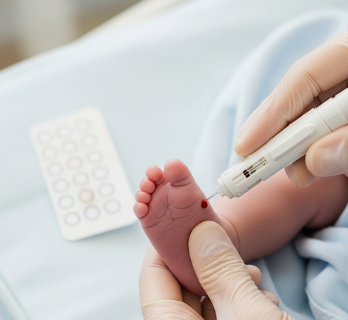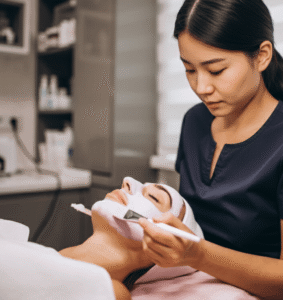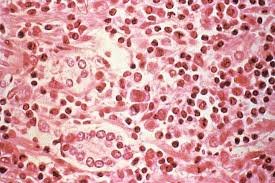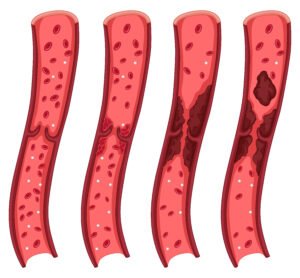What it is
The Newborn Blood Spot Test (also called the heel-prick test) is a screening procedure performed on newborns to detect rare but serious conditions early. It involves collecting a few drops of blood from the baby’s heel and analyzing them for genetic, metabolic, or hormonal disorders.
Key points:
- Typically performed within 48–72 hours after birth.
- Screens for conditions such as phenylketonuria (PKU), congenital hypothyroidism, cystic fibrosis, and sickle cell disease, depending on the region.
- Allows early intervention and treatment, improving health outcomes.
- Safe, quick, and minimally invasive.
Why it’s done
The test is performed to:
- Identify serious conditions early, before symptoms appear.
- Prevent complications, including intellectual disability, growth problems, or organ damage.
- Enable timely treatment, dietary management, or medical interventions.
- Support public health programs by monitoring the prevalence of specific disorders.
Note: Early detection is critical because many screened conditions can lead to irreversible damage if untreated.
Alternatives
Other newborn screening or diagnostic options include:
- Prenatal genetic testing: Detects some conditions before birth.
- Targeted testing: If family history suggests a specific disorder.
- Clinical observation: Monitoring for symptoms post-birth, but this is less effective than proactive screening.
Important: The blood spot test is preferred for early and comprehensive detection.
Preparation
Preparation for the test is minimal:
- Timing: Performed after the baby is at least 24 hours old and has been feeding.
- Parental consent: Parents should be informed about the purpose, conditions screened, and follow-up procedures.
- No fasting required: The baby can continue normal feeding.
- Hygiene: Clean the heel area before collecting the sample.
Patient instructions:
- Ensure the baby is warm and calm for easier blood collection.
- Be aware that results may take a few days to weeks depending on the tests conducted.
How it’s done
The procedure involves a simple heel prick:
- Positioning: The baby is held securely, usually on a parent’s lap.
- Cleaning: The heel is cleaned with an antiseptic.
- Blood collection: A small lancet punctures the heel, and a few drops of blood are collected on special filter paper.
- Drying and labeling: Blood spots are air-dried, labeled, and sent to a specialized laboratory.
- Analysis: Laboratory testing screens for multiple metabolic, hormonal, and genetic disorders.
Duration: Usually 5–10 minutes, with minimal discomfort for the newborn.
Recovery / Post-Test Considerations
Post-test care is straightforward:
- Heel care: Apply gentle pressure or a small bandage to stop bleeding.
- Comfort: Swaddle and soothe the baby; feeding can help calm them.
- Normal activities: The baby can continue regular feeding and sleeping patterns.
- Follow-up: Parents are contacted if any abnormal results are detected, prompting confirmatory tests and treatment.
Benefits:
- Early detection of life-threatening or disabling conditions.
- Enables timely medical intervention and monitoring.
- Improves long-term health outcomes and quality of life for affected infants.
Complications / Risks
The Newborn Blood Spot Test is generally safe, with minimal risks:
- Minor pain or bruising at the puncture site.
- Small amount of bleeding, which usually stops quickly.
- Inconclusive results: Occasionally, the test may need to be repeated due to insufficient blood.
- Parental anxiety: Receiving abnormal results may cause stress, but confirmatory tests clarify the outcome.
Prevention / Management:
- Proper technique and trained personnel minimize discomfort and ensure accurate sample collection.
- Clear communication with parents helps reduce anxiety.
- Immediate follow-up ensures early management if a condition is detected.
Treatment Options in Korea
The Newborn Blood Spot Test is widely available in hospitals and birthing centers across Korea:
Key features:
- Part of the national newborn screening program, covering multiple genetic and metabolic disorders.
- Performed by trained nurses or technicians in neonatal units.
- Follow-up care includes specialist consultation, confirmatory testing, and treatment plans.
- Early intervention programs ensure dietary, medical, or hormonal management as required.
- Supports public health monitoring and preventive healthcare initiatives.
Summary: The Newborn Blood Spot Test in Korea is a safe, quick, and essential screening tool for early detection of serious neonatal conditions. With timely testing, accurate results, and prompt intervention, it protects newborn health, prevents complications, and improves long-term outcomes.













